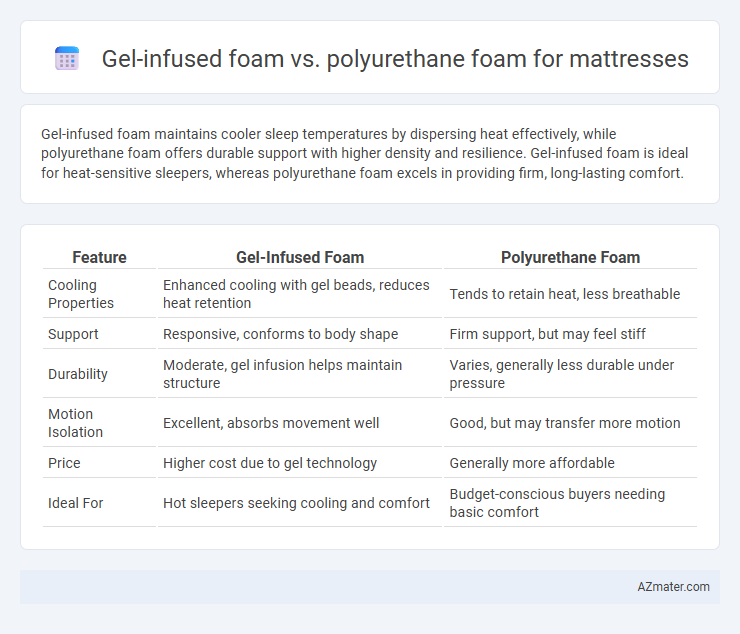Gel-infused foam maintains cooler sleep temperatures by dispersing heat effectively, while polyurethane foam offers durable support with higher density and resilience. Gel-infused foam is ideal for heat-sensitive sleepers, whereas polyurethane foam excels in providing firm, long-lasting comfort.
Table of Comparison
| Feature | Gel-Infused Foam | Polyurethane Foam |
|---|---|---|
| Cooling Properties | Enhanced cooling with gel beads, reduces heat retention | Tends to retain heat, less breathable |
| Support | Responsive, conforms to body shape | Firm support, but may feel stiff |
| Durability | Moderate, gel infusion helps maintain structure | Varies, generally less durable under pressure |
| Motion Isolation | Excellent, absorbs movement well | Good, but may transfer more motion |
| Price | Higher cost due to gel technology | Generally more affordable |
| Ideal For | Hot sleepers seeking cooling and comfort | Budget-conscious buyers needing basic comfort |
Introduction to Mattress Foam Technologies
Gel-infused foam incorporates cooling gel beads that enhance temperature regulation and improve breathability compared to traditional polyurethane foam, which is denser and offers firmer support with less heat dissipation. Mattress foam technologies have evolved to combine comfort, pressure relief, and durability by using advanced materials like gel infusion to address overheating issues common in polyurethane foam mattresses. Selecting between gel-infused and polyurethane foam depends on preferences for cooling properties, responsiveness, and support levels in modern mattress designs.
What is Gel-Infused Foam?
Gel-infused foam is a type of memory foam enhanced with gel beads or gel swirls to improve temperature regulation by dissipating body heat more effectively than traditional polyurethane foam. This innovation helps maintain a cooler sleeping surface, reducing heat retention commonly associated with standard polyurethane foam mattresses. Gel-infused foam also provides pressure relief and contouring support, making it a popular choice for those seeking both comfort and temperature control in a mattress.
Understanding Polyurethane Foam
Polyurethane foam is a widely used material in mattress construction known for its durability and support, formed by reacting polyols with isocyanates to create a flexible, closed-cell structure. Compared to gel-infused foam, polyurethane foam typically offers less temperature regulation but provides reliable pressure relief and a consistent firmness that supports spinal alignment. Understanding the chemical composition and density variations helps consumers select the right mattress foam based on comfort preferences and longevity requirements.
Temperature Regulation: Gel-Infused vs Polyurethane
Gel-infused foam excels in temperature regulation by incorporating gel particles that absorb and dissipate heat, providing a cooler sleep surface compared to traditional polyurethane foam. Polyurethane foam tends to retain body heat due to its dense structure, leading to increased warmth and reduced airflow. Therefore, gel-infused foam mattresses offer superior breathability and thermal comfort, especially for hot sleepers seeking temperature neutrality.
Pressure Relief and Support: A Comparative Analysis
Gel-infused foam offers enhanced pressure relief by distributing body weight more evenly and reducing heat retention compared to traditional polyurethane foam. Polyurethane foam provides firm support but may create pressure points, leading to discomfort during prolonged use. The gel infusion in foam mattresses improves contouring and spinal alignment, making them superior for pressure relief and support.
Durability and Longevity: Which Lasts Longer?
Gel-infused foam mattresses typically offer enhanced durability due to their open-cell structure and cooling gel infusion, which helps maintain shape and firmness over time. Polyurethane foam, especially standard variants, tends to degrade faster, losing support and developing indentations after prolonged use. High-density gel-infused foam models generally outlast standard polyurethane foams, providing longer-lasting comfort and structural integrity.
Allergen and Off-Gassing Concerns
Gel-infused foam mattresses offer superior resistance to allergens such as dust mites and mold compared to traditional polyurethane foam, making them a better choice for allergy sufferers. The infusion of gel not only enhances breathability but also reduces off-gassing by minimizing the release of volatile organic compounds (VOCs) typically associated with polyurethane foam. Consumers seeking a hypoallergenic sleep surface with lower chemical emissions often prefer gel-infused foam for its improved air quality and comfort.
Cost Comparison: Gel-Infused vs Polyurethane Foam
Gel-infused foam mattresses generally cost 20-30% more than standard polyurethane foam mattresses due to advanced cooling technology and enhanced pressure relief features. Polyurethane foam offers a budget-friendly option, typically priced between $200 and $500, while gel-infused foam mattresses range from $300 to $700 or higher. Consumers seeking value balance often consider polyurethane foam for affordability, whereas gel-infused foam suits those prioritizing temperature regulation and durability at a higher investment.
Which Foam is Best for Different Sleeping Styles?
Gel-infused foam offers enhanced cooling properties and pressure relief, making it ideal for hot sleepers and those needing support for side sleeping to reduce joint pain. Polyurethane foam, being denser and firmer, provides more support and durability, suitable for back and stomach sleepers who require spinal alignment and stability. Choosing between gel-infused and polyurethane foam depends on individual sleep posture and temperature preferences for optimal comfort.
Final Verdict: Choosing the Right Mattress Foam
Gel-infused foam offers enhanced temperature regulation and cooling properties by dispersing heat, making it ideal for those prone to overheating during sleep. Polyurethane foam provides durable support with varying densities and firmness levels but may retain more heat compared to gel-infused options. Selecting the right mattress foam depends on individual comfort preferences, heat sensitivity, and desired longevity, with gel-infused foam suited for cooler, breathable sleep and polyurethane foam preferred for budget-conscious buyers seeking supportive cushioning.

Infographic: Gel-infused foam vs Polyurethane foam for Mattress
 azmater.com
azmater.com